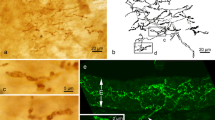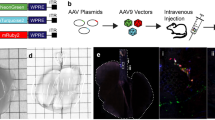Abstract
The G-protein subunit α-gustducin is a marker of chemoreceptive cells. In the present study, we examined the immunohistochemical localization of α-gustducin in rat airway epithelium both by light and electron microscopy. α-Gustducin immunoreactivity was found in solitary cells that presented ultrastructural features of chemoreceptor cells, i.e. flask-shaped or pear-shaped, with an apical process with thin microvilli protruding into the lumen. The immunostaining was mainly concentrated in the apical process and along the basolateral cell surface. To investigate whether α-gustducin-immunoreactive cells represented a distinct cell subset in rat airways, we performed double-label immunocytochemistry with antibodies to protein gene groduct (PGP) 9.5, a marker of neuroendocrine cells, and to phospholipase C beta2 (PLCβ2), a component of the bitter signalling pathway. α-Gustducin-immunoreactive cells were present in a subset of PGP-9.5-immunoreactive elements, although not all α-gustducin-positive cells expressed PGP 9.5 labelling. In addition, a subset of α-gustducin-expressing cells colocalized PLCβ2. This work thus demonstrates that solitary α-gustducin-immunoreactive cells exist throughout the airways and represent a specialized cell type with morphological and immunohistochemical characteristics of chemoreceptor cells.





Similar content being viewed by others
References
Adler E, Hoon MA, Mueller KL, Chandrashekar J, Ryba NJ, Zuker CS (2000) A novel family of mammalian taste receptors. Cell Mar 100:693–702
Boughter JD, Pumplin DW, Yu C, Christy RC, Smith DV (1997) Differential expression of alpha-gustducin in taste bud populations of the rat and hamster. J Neurosci 17:2852–2858
Clapp TR, Stone LM, Margolskee RF, Kinnamon SC (68–77001) Immunocytochemical evidence for co-expression of Type III IP3 receptor with signaling components of bitter taste transduction. BMC Neurosci 6:68–77
Cutz E, Jackson A (1999) Neuroepithelial bodies as airway oxygen sensors. Respir Physiol 115:201–214
Finger TE, Bottger B, Hansen A, Anderson KT, Alimohammadi H, Silver WL (2003) Solitary chemoreceptor cells in the nasal cavity serve as sentinels of respiration. Proc Natl Acad Sci USA 100:8981–8986
Hofer D, Drenckhahn D (1996) Cytoskeletal markers allowing discrimination between brush and other epithelial cells of the gut including enteroendocrine cells. Histochem Cell Biol 105:405–412
Hofer D, Puschel B, Drenckhan (1996) Taste receptor-like cells in the rat gut identified by expression of α-gustducin. Proc Natl Acad Sci USA 93:6631–6634
Hofer D, Asan E, Drenckhahn D (1999) Chemosensory perception in gut. New Physiol Sci 14:18–23
Kinnamon JC, Johnson EW, Tabata S, Crowley HH (1995) Immunocytochemical studies of PGP 9.5 in fetal and adult rat circumvallate taste buds. AchemS XVII Abstr 60
Kugler P, Hofer D, Mayer B, Drenckhahn D (1994) Nitric oxide synthase and NADP-linked glucose-6-phosphate dehydrogenase are co-localized in brush cells of rat stomach and pancreas. J Histochem Cytochem 42:1317–1321
Lewis Carl SA, Gillete-Ferguson I, Ferguson DG (1993) An indirect immunofluorescence for staining the same cryosection with two mouse monoclonal primary antibodies. J Histochem Cytochem 41:1273–1278
Luciano L, Reale E, Ruska H (1968) Über eine “chemorezeptive” Sinneszelle in der Trachea der Ratte. Z Zellforsch Mikrosk Anat 85:350–375
Medler KF, Margolskee RF, Kinnamon SC (2003) Electrophysiological characterization of voltage-gated currents in defined taste cell types of mice. J Neurosci 23:2608–2617
McDowell EM, Sorokin SP, Hoyt RF Jr (1994) Ontogeny of endocrine cells in the respiratory system of Syrian golden hamsters. I. Larynx and trachea. Cell Tissue Res 275:143–156
McLaughin SK, McKinnon PJ, Margolskee RF (1992) Gustducin is a taste-cell-specific G protein close related to the transducins. Nature 357:563–569
Negoescu A, Labat-Moleur F, Lorimier P, Lamarcq L, Guillermet C, Chambaz E, Brambilla E (1994) F(ab) secondary antibodies: a general method for double immunolabeling with primary antisera from the same species. Efficiency control by chemiluminescence. J Histochem Cytochem 42:433–437
Perez CA, Huang L, Rong M, Kozak JA, Preuss AK, Zhang H, Max M, Margolskee RF (2002) A transient receptor potential channel expressed in taste receptor cells. Nat Neurosci 5:1169–1176
Rossler P, Kroner C, Freitag J, Noe J, Breer H (1998) Identification of a phospholipase C beta subtype in rat taste cells. Eur J Cell Biol 77:253–261
Sbarbati A, Osculati F (2003) Solitary chemosensory cells in mammals? Cell Tissues Organs 175:51–55
Sbarbati A, Crescimanno C, Benati D, Osculati F (1998) Solitary chemosensory cells in the developing chemoreceptorial epithelium of the vallate papilla. J Neurocytol 27:631–635
Sbarbati A, Crescimanno C, Bernardi P, Osculati F (1999) Alfa-gustducin-immunoreactive solitary chemosensory cells in the developing chemoreceptorial epithelium of the rat vallate papilla. Chem Senses 24:469–472
Sbarbati A, Merigo F, Benati D, Tizzano M, Bernardi P, Crescimanno C, Osculati F (2004) Identification and characterization of a specific epithelium in the rat larynx. J Comp Neurol 475:188–201
Sorokin SP, Hoyt RF Jr, Shaffer MJ (1997) Ontogeny of neuroepithelial bodies: correlations with mitogenesis and innervation. Microsc Res Tech 37:43–61
Takami S, Getchell TV, McLaughlin SK, Margolskee RF, Getchell ML (1994) Human taste cells express the G protein a-gustducin and neuron-specific enolase. Mol Brain Res 22:193–203
Taira K, Shibasaki S (1978) A fine structure of the non-ciliated cells in the mouse tracheal epithelium with special reference to the relation of “brush cells” and “endocrine cells”. Arch Histol Jpn 41:351–366
Widdicombe J (2001) Airway receptors. Respir Physiol 125:3–15
Wong GT, Gannon KS, Margolskee RF (1996a) Transduction of bitter and sweet taste by gustducin. Nature 381:796–800
Wong GT, Ruiz-Avila L, Ming D, Gannon KS, Margolskee RF (1996b) Biochemical and transgenic analysis of gustducin’s role in bitter and sweet transduction. Cold Spring Harb Symp Quant Biol 61:173-184
Yamamoto Y, Kusakabe T, Hayashida Y, Yoshida T, Matsuda H, Atoji Y, Suzuki Y (2000) Laryngeal endocrine cells: topographic distribution and adaptation to chronic hypercapnic hypoxia. Histochem Cell Biol 114:277–282
Yang R, Tabata S, Crowley HH, Margolskee RF, Kinnamon JC (2000) Ultrastructural localization of gustducin immunoreactivity in microvilli of type II taste cells in the rat. J Comp Neurol 425:139–151
Yu YC, Miyazaki J, Shin T (1996) Neuroendocrine cells in the cat laryngeal epithelium. Eur Arch Otorhinolaryngol 253:287–293
Zancanaro C, Mucignat Caretta C, Merigo F, Cavaggioni A, Osculati F (1999) Alpha-gustducin expression in the vomeronasal organ of the mouse. Eur J Neurosci 11:4473–4475
Author information
Authors and Affiliations
Corresponding author
Rights and permissions
About this article
Cite this article
Merigo, F., Benati, D., Tizzano, M. et al. α-Gustducin immunoreactivity in the airways. Cell Tissue Res 319, 211–219 (2005). https://doi.org/10.1007/s00441-004-1007-2
Received:
Accepted:
Published:
Issue Date:
DOI: https://doi.org/10.1007/s00441-004-1007-2




